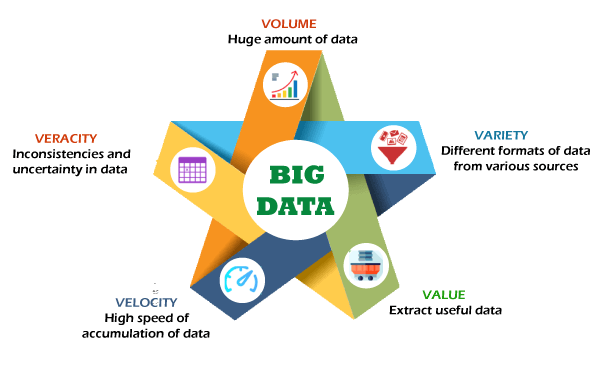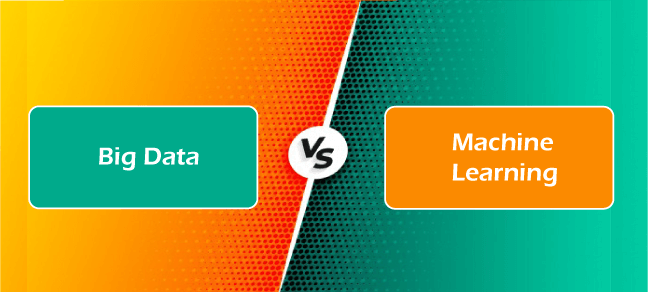What is Big Data and Machine LearningBig Data and Machine Learning have become the reason behind the success of various industries. Both these technologies are becoming popular day by day among all data scientists and professionals. Big data is a term that is used to describe large, hard-to-manage, structured, and unstructured voluminous data. Whereas, Machine learning is a subfield of Artificial Intelligence that enables machines to automatically learn and improve from experience/past data. Both Machine learning and big data technologies are being used together by most companies because it becomes difficult for the companies to manage, store, and process the collected data efficiently; hence in such a case, Machine learning helps them. Before going in deep with these two most popular technologies, i.e., Big Data and Machine Learning, we will discuss a quick introduction to big data and machine learning. Further, we will discuss the relationship between big data and machine learning. So, let's start with the introduction to Big data and Machine Learning. What is Big Data?Big Data is defined as large or voluminous data that is difficult to store and also cannot be handled manually with traditional database systems. It is a collection of structured as well as unstructured data. Big data is a very vast field for anyone who is looking to make a career in the IT industry. Challenges in Big DataBig data has tremendous growth and collection of structured as well as unstructured data. Almost all companies are using this technology for running their business and to store, process, and extract value from a bulk amount of data. Hence, it is becoming a challenge for them to use the collected data in the most efficient way. There are a few challenges while using Big data are, which are as follows:
5V's in Big DataBig data is defined by 5V's, which refers to the volume, Variety, value, velocity, and veracity. Let's discuss each term individually. 
Data can be structured as well as unstructured and comes from various sources. It can be audio, video, text, emails, transactions, and many more. Due to various formats of data, storing, managing, and organizing the data becomes a big challenge for organizations. Although storing raw data is not difficult but converting unstructured data into a structured format and making them accessible for business uses is practically complex for IT expertise.
Rendering and data sorting is very necessary to control data flows. Further, the superiority of processing data with high accuracy and speed is also necessary for storing, managing, and organizing data in an efficient manner. Smart sensors, smart metering, and RFID tags make it necessary to deal with huge data influx in almost real-time. Sorting, assessing, and storing such deluges of data in a timely fashion become necessary for most organizations.
In general, Veracity refers to the accuracy of data sets. But when it comes to Big data, it is not only limited to the accuracy of big data but also tells us how trustworthy is the data source. Further, it also determines the reliability of data and how meaningful it is for analysis. In one line, we can say Veracity is defined as the quality and consistency of data.
Value in Big Data refers to the meaningful or usefulness of stored data for your business. In big data, data is stored in structured as well as an unstructured format, but regardless of its volume, usually, it is not meaningful. Hence, we need to convert it into a useful format for the business requirements of organizations. For e.g., data having missing or corrupt values, missing key structured elements, etc., are not useful for companies to provide better customer service, create marketing campaigns, etc. Hence, it leads to reducing the revenue and profit in their businesses. Sources of data in Big Data Big data can be of various formats of data either in structured as well as unstructured form, and comes from various different sources. The main sources of big data can be of the following types:
Data is collected from various social media platforms such as Facebook, Twitter, Instagram, Whatsapp, etc. Although data collected from these platforms can be anything like text, audio, video, etc., the biggest challenge is to store, manage and organize these data in an efficient way.
There are various online cloud platforms, such as Amazon AWS, Google Cloud, IBM cloud, etc., that are also used as a source of big data for machine learning.
The Internet of Things (IoT) is a platform that offers cloud facilities, including data storage and processing through IoT. Recently, cloud-based ML models are getting popular. It starts with invoking input data from the client end and processing machine learning algorithms using an artificial neural network (ANN) over cloud servers and then returning with output to the client again.
Nowadays, every second, thousands of web pages are created and uploaded over the internet. These web pages can be in the form of text, images, videos, etc. Hence, these web pages are also a source of big data. What is Machine Learning?Machine Learning is one of the most crucial subsets of Artificial Intelligence in the computer science field. It is referred to as the study of automated data processing or decision-making algorithms that improve themselves automatically based on experience or past experience. It makes systems capable of learning automatically and improves from experience without being explicitly programmed. The primary aim of a machine learning model is to develop computer programs that can access data and use it for learning purposes. With the rise in Big Data, Machine Learning has become a key player in solving problems in various areas such as:
Difference between Big Data and Machine Learning
With the rise of big data, the use of machine learning has also increased in all industries. Below is the table to show the differences between machine learning and big data as follows:
Big data with Machine LearningBig Data and Machine Learning both technologies have their own advantages and aren't competing for concepts or mutually exclusive. Although both are very crucial individually, when combined, they provide the opportunity to achieve some incredible results. When talking about 5V's in big data, machine learning models helps to deal with them and predict accurate results. Similarly, while developing machine learning models, big data helps to extract high-quality data as well as improved learning methods by means of providing analytics teams. There is no secret that almost all organizations, such as Google, Amazon, IBM, Netflix, etc., have already discovered the power of big data analytics enhanced by machine learning. Machine Learning is a very crucial technology, and with big data, it has become more powerful for data collection, data analysis, and data integration. All big organizations use machine learning algorithms for running their business properly. We can apply machine learning algorithms to every element of Big data operation, including:
In machine learning algorithms, we need multiple varieties of data for training a machine and predicting accurate results. However, sometimes it becomes difficult to manage these bulkified data. So, it becomes a challenge to manage and analyze Big Data. Further, this unstructured data is useless until it is well interpreted. Thus, to use information, there is a need for talent, algorithms, and computing infrastructure. Machine Learning enables machines or systems to learn from past experience and use data received from big data, and predict accurate results. Hence, this leads to generating improved quality business operations and building better customer relationship management. Big Data helps machine learning by providing a variety of data so machines can learn more or multiple samples or training data. In such ways, businesses can accomplish their dreams and get the benefit of big data using ML algorithms. However, for using the combination of ML and big data, companies need skilled data scientists. How to apply Machine Learning in Big dataMachine Learning provides efficient and automated tools for data gathering, analysis, and integration. In collaboration with cloud computing superiority, machine learning ingests agility into processing and integrates large amounts of data regardless of its source. Machine learning algorithms can be applied to every element of Big Data operation, including:
All these stages are integrated to create the big picture out of Big Data with insights, patterns, which later get categorized and packaged into an understandable format. ConclusionIn this article, we have discussed Big data and machine learning separately and the basic differences between both technologies. Also, we have seen how machine learning and big data can be used together to learn machine learning models using the high quality of data from the huge amount of unstructured as well as structured data. Further, we have also seen some applications that use big data and machine learning and provide amazing results.
Next TopicHow to Save a Machine Learning Model
|
 For Videos Join Our Youtube Channel: Join Now
For Videos Join Our Youtube Channel: Join Now
Feedback
- Send your Feedback to [email protected]
Help Others, Please Share










